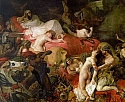Romanticism |
Romanticism |

|
Romanticism is a difficult historical label. Most writers and artists did not think of themselves as living in the "Romantic" age or even of constituting an historic movement. In addition, scholars disagree about when Romanticism occurred, partly because notable characteristics occurred at different places at different times. Chronological boundaries also depend on what media one is defining. Music scholars, for example, see almost all of the 19th century as the Romantic period while art historians sometimes define the last decades of the 18th century through the first half of the 19th century as Romantic. In contrast, British literary historians only define the first three decades of the 19th century as Romantic. And the broadest view suggests that "Romanticism" comprises a set of values, seen off and on throughout history. Confused?
What is important is that you gain some understanding of what constitutes Romanticism, what attitudes are dominant, what world views are embraced. Some important visual artists' names will recur as well: Delacroix in France, Constable and Turner in Great Britain, and Friedrich in Germany. | |
 |
Characteristics of Romanticism |
 |
Romantic Attitudes toward Nature |
 |
Romantic Attitudes toward Humankind |
All images marked MAS were photographed on location by Mary Ann Sullivan. All other images were scanned from other sources or downloaded from the World Wide Web; they are posted on this password-protected site for educational purposes, at Bluffton College only, under the "fair use" clause of U.S. copyright law.